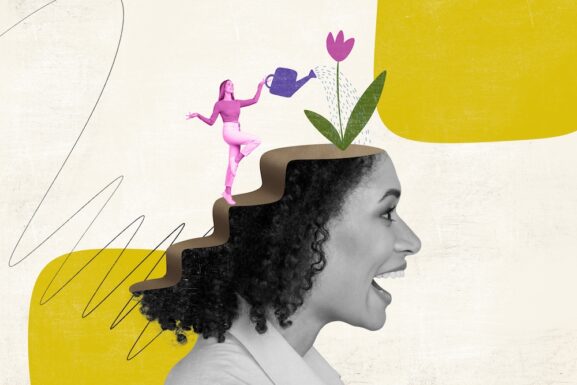rTMS vs. dTMS Therapy – Here are the Key Differences
If you’ve been looking for alternative treatments for conditions like major depressive disorder (MDD) or obsessive compulsive disorder (OCD), you might have run across transcranial magnetic stimulation (TMS therapy).
What is TMS? What are the differences between rTMS vs. dTMS? Is repetitive TMS (rTMS) better than Deep TMS™ (dTMS)?
For those curious about TMS as a potential therapy, continue reading.
Interested in TMS Therapy? Click Here To Find TMS Clinics Near You
TMS Therapy: The Basics
Transcranial magnetic stimulation (TMS) is a non-invasive treatment that pulses magnetic fields through the skull, regulating the activity of brain structures associated with different mental health conditions.
“Transcranial magnetic stimulation, or TMS, is a medical procedure where a powerful electromagnet stimulates the brain in a pattern that either speeds up or slows down the firing of neurons,” explained Dr. Owen Muir, a dual-board certified psychiatrist. “This leads to healing from a variety of conditions.”
There are two major types of TMS therapy available today: repetitive TMS (rTMS) and deep TMS (dTMS). The names might be misleading, but, when comparing rTMS vs. dTMS, one thing is clear: Each administers magnetic pulses during treatment.
In studies, both rTMS and dTMS show long-lasting improvements in depression symptoms. Additionally, both treatments have FDA approval.
While rTMS was first FDA-approved for depression in 2008, and dTMS for depression in 2013. Furthermore, dTMS has received additional FDA-approvals for obsessive-compulsive disorder (OCD) and smoking cessation.
In Europe, dTMS also has approval for the treatment of the following:
- Alzheimer’s disease (AD)
- Autism
- Bipolar disorder
- Chronic pain
- Multiple sclerosis (MS)
- Parkinson’s disease
- Post-stroke rehabilitation
- Post-traumatic stress disorder (PTSD)
Overall, both rTMS and dTMS work in similar ways — and with similar technologies. However, there are some important differences between rTMS vs. dTMS.
TMS Clinic Spotlight: Inland Psyche in Corona, California
What Is rTMS?
rTMS was first approved in 2008 for the treatment of major depressive disorder (MDD) in adults who were not responding to antidepressants or other prescription medications and treatments.
The coils used in rTMS can generate pulses that penetrate about 1.5-2 cm into the brain. These coils are placed on the scalp to painlessly deliver electromagnetic pulses — which stimulate nerve cells in regions of the brain associated with mood.
“Repetitive TMS is traditionally done with a magnetic coil in the shape of a figure eight,” explained Dr. Muir. “This creates a very small area of target so it can be precisely pointed at one spot or another in the brain.”
Because of coil design and depth of penetration, one of the major downsides in rTMS is that it can lack precision.
“If you don’t point it precisely, you can miss the spot [you’re trying to target],” said Dr. Muir.
The upside is that clinical studies have shown that, after six weeks (30 sessions) of treatment, about 58 percent see an improvement in depression symptoms. About 37 percent of patients achieve remission.
RELATED: TMS Or Ketamine: Which Is More Effective? Breaking Down The Two Alternative Treatments
What Is dTMS?
dTMS uses a different delivery system, developed by BrainsWay. It was first approved in 2013 for patients suffering from difficult to treat episodes of major depressive disorder. Since then, it has also been FDA-approved for smoking cessation and obsessive compulsive disorder (OCD).
“Deep TMS uses patented flexible H coils that conform to the shape of the head inside a cushioned helmet,” explained Dr. Aron Tendler, Chief Medical Officer of BrainsWay Deep TMS Treatment.
Deep TMS also uses different coil designs: The H-1 coil, the H-4 coil and the H-7 coil. Dr. Tendler said that the H coils have a broader and deeper area of stimulation than do the figure eight coils used in rTMS. The rate of penetration for these coils ranges from 3-3.5 cm.
According to BrainsWay’s own clinical data looking at Deep TMS for depression, after 20 treatment sessions, 64 percent of participants responded positively to the treatment. Overall, 42 percent achieved remission.
BrainsWay’s study of Deep TMS for OCD showed that a majority (59 percent) of participants saw at least some reduction in symptoms.
RELATED: Fisher Wallace Stimulator vs. TMS Therapy
rTMS vs. dTMS: What’s The Difference?
Both rTMS and dTMS use electromagnetic pulses to stimulate the brain, but “they differ in the physics of the electromagnetic coils,” said Dr. Tendler.
Deep TMS coils are able to reach deeper structures of the brain in a broader area. “The deeper, broader field enhances targeting of the correct brain region,” explained Dr. Tendler. In turn, this reduces the risk of missing relevant brain targets, improving efficiency.
There hasn’t been a lot of direct head-to-head comparison of rTMS vs. dTMS in clinical trials.
One independent and randomized placebo-controlled study looking at depression showed that dTMS led to higher positive response rates, as well as a greater reduction in symptoms. Both rTMS and dTMS achieved similar remission rates.
A final major point of difference between rTMS vs. dTMS is in their FDA-approval status.
BrainsWay’s H-4 and H-7 coils have been approved for use in treating smoking cessation and OCD, respectively. According to Dr. Muir, there are several other H-coil helmets currently in development.
What Is TMS Therapy Protocol?
Most TMS therapy sessions occur in a doctor’s office or hospital. While treatment protocols vary, they often call for daily sessions over the course of several weeks. There aren’t any research studies looking at the efficacy of maintenance sessions — though it is an option that you can discuss with a doctor.
Does TMS Have Side Effects?
Generally, both rTMS and dTMS are considered safe and well-tolerated treatments. Still, like most treatments, there are common side effects to be aware of, including:
- Headache
- Scalp discomfort at the site of stimulation
- Tingling, spasms or twitching of facial muscles
- Lightheadedness
If you’re experiencing side effects, you can speak with your doctor — who may adjust the level of stimulation or suggest taking an over-the-counter pain medication before treatment. Many patients find that side effects decrease over time.
Will Insurance Cover TMS Therapy?
With the FDA approving TMS for treatment, insurance may cover the procedure. While many insurance plans will cover the FDA-approved use for depression, coverage for OCD and smoking cessation is not as widespread.
Speak with your insurance company and your TMS clinic to find out if you will be covered. Most insurance companies need proof of diagnosis and medical history showing that you have attempted other treatments like medication and therapy.
rTMS vs. dTMS – Which One Is A Better Option?
Is one form of transcranial magnetic stimulation better than another? It really depends on your needs, condition, and other considerations like insurance coverage.
If you’re looking to treat OCD or quit smoking, dTMS might be more targeted and effective treatments. But not all insurance providers will cover dTMS for these uses.
With that said, both dTMS and rTMS are safe and efficacious treatments. Both have proven helpful to patients who have not found success with other medications or treatments.



